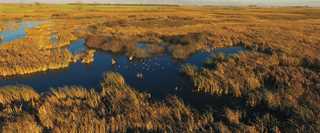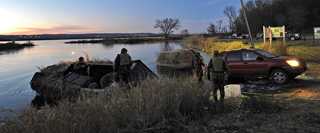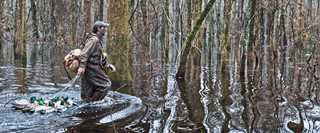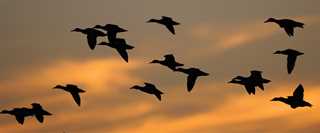Public Waterfowling Secrets
Follow these expert tips to maximize your opportunities on public lands
Follow these expert tips to maximize your opportunities on public lands

By Chris Jennings
The greatest advantage of public waterfowling areas is that they are open to all. That can also be their biggest drawback. The best spots are often crowded, and everyone is looking for an edge over the competition. Fortunately, duck hunting experts are willing to share secrets they've learned over decades of freelance waterfowling. Here are their tips for beating the crowds and bagging more birds on public hunting areas.

Photo © TRAVIS MUELLER/BANDED OUTDOORS
Observing how ducks behave on the water can help you improve your decoy placement, says Dr. Joe Sands, a wildlife biologist with the U.S. Fish and Wildlife Service (USFWS) in the Pacific Northwest. Sands participates in aerial surveys during spring and winter, and these flyovers offer him a unique perspective on the behavior of waterfowl. He uses the observations he makes during these surveys to adjust his decoy strategies when hunting public areas in Oregon.
"When you look at flocks of ducks from the air, the birds are really clumped together and competing for food," Sands says. "They are also haphazardly distributed, like their food sources. The birds are not just spread out across the water, but are packing into the areas where the food is."
This random distribution of pockets of feeding ducks stands out in stark contrast to what Sands sees when he observes decoy spreads from the air. "Unwittingly, hunters seem to evenly distribute their decoys throughout the area, and that's not how ducks typically look on the water from above," he says.
To create the most realistic spread possible, Sands sets his decoys to mimic the natural bunching of feeding ducks. "There may be several pockets of a certain food source in one location, so I want my spread to look like the ducks are clustering in different feeding groups," he says.

Photo © JIM THOMPSON
Utah's Great Salt Lake basin offers an abundance of public waterfowling opportunities, but when conditions are right, the competition for good hunting spots can be stiff. Jeff Bringhurst, who has been hunting around the Great Salt Lake for 30-plus years, looks to gain any advantage he can over his fellow waterfowlers. By volunteering with state or federal agencies that manage these public lands, he is able to get behind-the-scenes information about the places that are most likely to hold waterfowl.
"I have volunteered to help local public land managers with duck and goose banding, food planting, and phragmites-control programs," Bringhurst explains. "Riding around with staff is a great way to get out and find new hunting spots-places that other hunters have overlooked."
Bringhurst adds that volunteering has also helped him gain valuable information from biologists and other hunters. "The more you learn about the land and its management, the better you can apply that knowledge to your hunting strategies. For example, chemical treatments of phragmites can encourage growth of sago pondweed and other prime waterfowl foods. Knowing which areas were recently sprayed is valuable information during duck season," he says.
According to Bringhurst, volunteering not only gives him insider information, but also provides land managers with much-needed help. "They are managing huge tracts of habitat, often with only a handful of staff. There is always something to do out there, and gaining useful information while helping improve the habitat is beneficial for everyone," he says.
Pat Kalmerton, guide and owner of Wolf Pack Adventures in Sheboygan, Wisconsin, hunts public marshes across the state, including those on Lake Michigan and the Wisconsin River. Key to his success is gathering intelligence on local marsh conditions before the season starts.
"Taking aerial photographs of the vegetation in these areas is vital to our hunting prospects," Kalmerton says. "Google Earth isn't updated enough to get absolutely reliable information, so we send up a plane in early fall to take aerial pictures of the marshes, islands, and points that we plan to hunt. This gives us an idea of the features of the marsh and where birds are likely to congregate. It also helps us find the best places to set our decoys and conceal ourselves in different wind conditions."
Once the season begins, Kalmerton and his guides emphasize the need to tread lightly in and around their best hunting spots. They are sticklers about keeping the natural cover in these areas as untrammeled as possible, because remaining concealed is imperative for success.
"In the public areas that we hunt, we see guys dragging boats into high grasses, mowing down cattails, and even running mud motors through backwater potholes. Such activities can ruin these ideal resting areas for ducks," Kalmerton says. "Always do whatever you can to avoid knocking down the vegetation. Once it's gone, the hunting becomes a lot tougher. In some areas, I've had to resort to tying cattails together and using decoy poles to try to get them to stand back up. It really is that important to maintain the natural vegetation for concealment."
Waterfowlers who hunt on public land can be tight-lipped not only about where they go, but also about their go-to tactics for a successful hunt. Cory Thompson of Kennewick, Washington, takes a different approach. He believes that talking with other hunters may be in everyone's best interest, and he often shares information-and even his hunting spots-with other waterfowlers.
Thompson is a forestry technician with the USFWS at the Mid-Columbia River National Wildlife Refuge Complex in eastern Washington and northeastern Oregon. He also works part-time at the refuge's check stations during hunting season, and it is through this latter job that he has learned the value of partnering with other hunters.
"The blinds on this refuge allow four hunters, and sometimes a hunting party will have only two or three," Thompson says. "When I'm not lucky enough to draw a blind in the lottery system, I may ask if I can join one of these short-handed hunting parties. It doesn't hurt to ask. On the other hand, if I have a lottery spot and I'm hunting alone, I don't hesitate to ask other hunters to join me. There are many benefits to doing this."
One big plus is finding new hunting partners, says Thompson, who has seen his waterfowling opportunities expand along with his list of newfound friends. "Several of the people I hunt with regularly now are guys I've met while partnering on refuge hunts," he says. "Pooling resources can also improve your odds by increasing the size of your decoy spread. Setting out a spread that's larger than the typical rig can make a difference on public land."

Photo © JIM THOMPSON
As a world duck calling champion, Jim Ronquest has an obvious advantage over the masses of waterfowlers who hunt the public flooded timber near his hometown of Stuttgart, Arkansas. Even so, the producer of RNT-V is a big believer in the importance of working in tandem with the other callers in your duck blind to finish wary late-season birds.
"If you typically hunt with the same guys, learning how to work together when calling will benefit you," he says. "Try not to call on top of one another. If I'm blowing a call, wait until I'm done before you start-otherwise all those calls will run together."
After years of hunting together, Ronquest and his crew know how to read and work ducks as a team by synchronizing their calling routine. "If pressured ducks are responding and your partner hits them with a good lick and they turn back into the wind, don't feel like you have to call," he says. "Your timing may be off and you'll push those ducks away from the hole. Reading the ducks' reactions and having the ability to call as a team makes a big difference in finishing a flock."

Photo © TODDSTEELEPHOTOART.COM
Mike Sertle, Ducks Unlimited regional biologist for Indiana and Illinois, works and hunts in the heart of the Ohio and Mississippi River floodplains. The smaller streams and creeks that feed into these big river systems offer an abundance of bottomland habitats for migrating waterfowl. According to Sertle, determining where to hunt involves carefully monitoring water levels in these areas year-round.
"I watch the river levels throughout the year more than I track the weather," Sertle says. "A big rain and flood in summer could potentially result in great habitat for migrating ducks come fall. It might also saturate a moist-soil area, resulting in an abundance of waterfowl food sources. The rivers offer a wide range of opportunities, but knowing the difference between one area and the next will help lead you to the ducks."
Maintaining a watchful eye on river levels becomes even more important when the season starts. Even the slightest fluctuations can bring significant changes for waterfowl seeking quality food sources. "One of the spots that I hunt is inaccessible when the river gauge is at 8.5 feet," explains Sertle, "but when the river rises a little higher, small pockets of this low-lying area receive a few inches of water. This small change attracts ducks immediately. As the season progresses and ducks' behaviors change, so does their need for certain types of habitats."
Duck blinds in public waterfowling areas can lose much of their camouflage by midseason, says Thompson, who hunts primarily at McNary National Wildlife Refuge near Burbank, Washington. "Halfway through the season, the metal blinds on the refuge tend to lose their brush, so I'm careful to add more vegetation to my blind before the hunt," he says. "I'll do this by gathering tumbleweeds or some cattails from the surrounding area and applying them to the blind to make sure it's concealed."
Although Thompson prefers using vegetation gathered from the area around the blind, he often sees other hunters carrying in artificial grass mats or burlap to improve the concealment of the refuge blinds.
"Never assume that the blind itself provides enough cover," he says. "Being completely concealed out here is the best way to improve your odds for a successful hunt."
Having detailed knowledge of an area means you know what to expect. But becoming too cozy with one spot can cause you to overlook other opportunities, says Ronquest, who recommends keeping your hunting options open to make the most of your days afield.
"As we travel the country for RNT-V, what I've learned is that having local experience in a public hunting area may not always be the best thing," he says. "Sometimes the 'best' spots or blinds on the river don't turn out to be the most productive. If the conditions are changing and you've always relied on one good hunting hole, you can limit yourself into thinking that it's still the best hole, even though the conditions might be showing you otherwise."
As Ronquest attempts to locate ducks on an unfamiliar public hunting area, he will often wait until first light to see where the birds are working. What he discovers may go against everything that local hunters have told him about how the ducks are feeding, resting, or loafing on that spot.
"If it's a two- or three-day hunt, just being out there the first day to get a feel for the property and how the ducks are working is the best plan," Ronquest says. "Relying on good local information helps, but it isn't the key to our success. Many times we end up having great shoots in areas that other hunters have overlooked. This tells me that we all need to stay on our toes. Don't fall into a rut. Keep your eyes open for better opportunities."
Ducks Unlimited uses cookies to enhance your browsing experience, optimize site functionality, analyze traffic, and deliver personalized advertising through third parties. By continuing to use this site, you agree to our use of cookies. View Privacy Policy